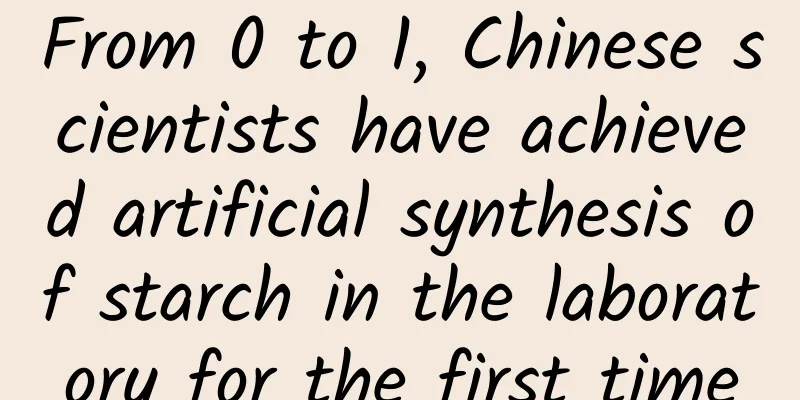From 0 to 1, Chinese scientists have achieved artificial synthesis of starch in the laboratory for the first time

|
Produced by: Science Popularization China Produced by: Li Lei Producer: Computer Network Information Center, Chinese Academy of Sciences Recently, the Tianjin Institute of Industrial Biotechnology, Chinese Academy of Sciences, has made major breakthroughs in the artificial synthesis of starch, achieving the first de novo synthesis of starch from carbon dioxide. The related work was published in the top international journal Science on September 24, 2021. Starch is the main component of grain. Does this technology make it possible to live on nothing? What impact will the breakthrough in carbon dioxide artificial starch synthesis technology have on the future, and how important is it? Let’s first take a look at the official evaluation: Image source: provided by the author The biggest feature of this synthesis is that it does not use cells (cell-free). In nature, cells can synthesize starch from carbon dioxide through photosynthesis. Image source: provided by the author But the problem with photosynthesis is that chloroplasts are required. For the vast majority of organisms on Earth, only plants and some animals can accomplish this. The characteristic of this research is: pure industrial/laboratory synthesis. The roadmap for this research is as follows Image source: provided by the author Briefly speaking, the experiment is as follows: First, carbon dioxide is reduced to methanol using an inorganic catalyst, then methanol is converted into three carbons, then the three carbons are synthesized into six carbons, and finally, they are polymerized into starch. Compared with standard natural starch, its structure is basically the same. Both the absorption peak and the NMR signal prove that this synthetic starch is very close to natural starch. Image source: provided by the author The picture below is a real picture of synthetic starch (Photo provided by the Science and Technology Photography Alliance of the Chinese Academy of Sciences) How important is artificial starch? Let’s start from small to large: 1. Simple steps In nature, it takes about 60 biochemical reactions and complex physiological regulation for organisms to synthesize starch from carbon dioxide, but this artificial synthesis only requires 11 steps. 2. Fast speed and high efficiency The rate of this laboratory synthesis is 8.5 times that of corn starch. Theoretically, the annual starch production of a 1-cubic-meter bioreactor is equivalent to the annual starch production of 5 mu of corn fields in my country. This new route makes it possible to transform starch production from traditional agricultural cultivation to industrial manufacturing, and opens up a new technological route for synthesizing complex molecules from carbon dioxide. In addition, according to reports, this synthesis efficiency is also high. The efficiency of synthesizing starch in nature is about 2% (corn), while the efficiency of industrial synthesis can reach more than 10%. 3. Vision Food is the primary need of the people. Agricultural issues have always been related to the survival of mankind. The use of this synthetic method can solve the problem of arable land and fresh water resources required for agriculture, avoid the use of pesticides and fertilizers, and improve food security. my country has more than 1.5 million square kilometers of arable land, accounting for about 16% of the country's land area, that is, less than one-fifth. The rest of the country's land area cannot be used as arable land, which has made my country's food problem very serious. With this technology, mountain valleys, deserts, and ice fields can all become agricultural production areas. Image source: veer gallery Since ancient times, my country's water transport system has required a very busy transportation of grain and other materials. With this technology, many places without conditions for growing crops can directly produce starch. 4. Greenhouse problem, global warming Global warming can be said to be a problem that has been plaguing all of humanity over the years. Image source: provided by the author The core factor causing global warming is the greenhouse gas carbon dioxide. Industrial production, automobile emissions, etc. are all factors that lead to the increase of carbon dioxide. Although plants have been continuously fixing carbon dioxide, they are still not as high as carbon dioxide emissions. Image source: provided by the author With this technology, carbon dioxide can be fixed directly, which is much more efficient than agriculture and plants. Wouldn’t that solve the greenhouse gas problem? 5. The more distant future The space station and even the journey into the universe are guaranteed. In the past, we envisioned two solutions to the problem of long-distance space travel: one is to carry enough food; the other is to let humans hibernate to reduce energy consumption. But as long as you wake up, you always need food. Many science fiction films have scenes of aliens farming, such as "The Martian" where they go to Mars to plant potatoes. Image source: Stills from The Martian If we have artificial starch synthesis technology, these problems can be solved well. Even in barren land, as long as there is carbon dioxide and related materials, starch can be synthesized directly. Image source: provided by the author For example, the atmosphere of Mars is mainly carbon dioxide, accounting for 96%, which is simply a new granary. Moreover, carbon dioxide itself is a waste product of human metabolism and can be directly recycled. 6. One question: energy! The conversion of starch to carbon dioxide is a gradual process of energy release. Glucose then turns into carbon dioxide This step is equivalent to swimming upstream, which requires energy. So, where does the energy come from? This may require new energy. Currently, my country is also actively developing new energy, especially nuclear energy, and hopes to achieve controlled nuclear fusion within 50 years. Image source: provided by the author It should be emphasized that the current research results are still in the laboratory stage and this technology is still far from being applied. But this technology is a breakthrough from 0 to 1, and its importance is self-evident. Just like when Faraday discovered the electromagnetic induction phenomenon, a noble lady once asked him: "What is the use of electricity?" Faraday cleverly asked, "What good are newborn babies?" |
<<: Why is the anti-cancer drug so expensive at 1.2 million per injection?
>>: Why are there so many rocks floating in the vast universe? How many planets are made of rocks?
Recommend
The evolution of AI technology is underestimated by the public
ChatGPT, recently launched by OpenAI, has become ...
Hold your breath and count “8” to judge your lung capacity?
How many lines of "8" can your lung capa...
New User Activation from the Aha Moment
In 2008, when you were staying in your dormitory ...
Six warnings issued simultaneously! The cold wave continues to intensify, and the Spring Festival travel needs attention →
The Central Meteorological Observatory continued ...
6 good ways to clean up mobile phone garbage, 99% of people don’t know!
The phone memory is always insufficient, and clea...
WeChat Moments Ads Launches oCPM, Let’s Take a Look at Its New Features
Performance advertisers often encounter this diff...
3 tips for information flow optimization + 8 cases, if you don’t believe me, you can’t do it well!
With the arrival of winter vacation, many busines...
Which is better, vitamin C that costs 2 yuan or vitamin C that costs hundreds of yuan?
Speaking of vitamin C, many people think it is a ...
User operation customer acquisition and conversion methods!
Today I will introduce to you ARGO, a user operat...
Is “use it and leave it” outdated? Lessons from the Battle Between Two Giants of Android Optimization Tools
Zhang Xiaolong said in a public speech last year ...
3000 words revealing the secrets of advertising on Xiaohongshu!
When it comes to the most popular APP in 2019, Xi...
42 people infected in 8 districts! Beijing routinely conducts nucleic acid testing, everything you want to know is here
On May 10, Beijing held a press conference on the...
Several existing problems and solutions for App Store search
Apple's volatility has only increased recentl...
I would like to call this Android automation APP a magic tool!
[[385362]] Friends who have used Android phones s...









